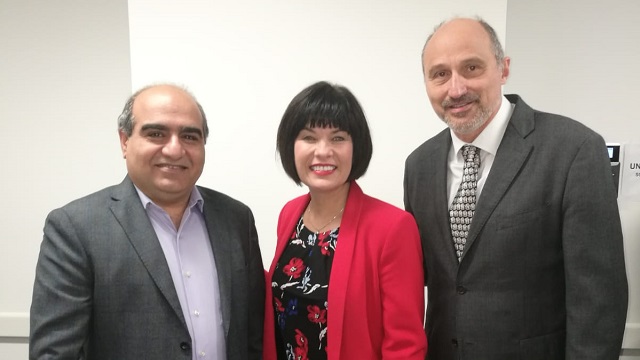
Dr. Amir Landi (L) and Dr. Luis Nacul (R) were joined by Canada's Minister of Health, Ginette Petitpas Taylor, at the announcement of $1.4 million from CIHR for the new ICanCME research network in early September.
The Interdisciplinary Canadian Collaborative ME Research Network, or ICanCME (pronounced 'I can see ME') is the first-ever of its kind addressing the issue of ME. The network brings together 70 researchers, community partners and patients from across Canada to find the cause of, and possible treatments for, ME through patient-centred research-from discovery all the way through to clinical tests and implementation.
"ME is a complex and multisystem disease that is very difficult to diagnose, which has made it what I call a 'missed disease,'" said Amir Landi, senior scientist with the Li Ka Shing Applied Virology Institute and one of the founding members of the network. "So this network is important because it creates the right environment for Canadian researchers, clinicians and patient advocates to do scientific research into ME in a very collaborative way."
Landi is joined in the network by three other U of A researchers: John Ussher, assistant professor from the Faculty of Pharmacy & Pharmaceutical Sciences; Sunita Vohra, director of the CARE program in the Department of Pediatrics and director of the U of A's Integrative Health Institute; and Salima Punja, senior research associate in the Department of Pediatrics and executive director of the Integrative Health Institute. The four will be part of a number of working groups tasked with investigating the various aspects of the disease and establishing scientific priorities for research.
Get to know ME
It is estimated that more than 580,000 Canadians live with ME, also known as chronic fatigue syndrome, or ME/CFS. This poorly understood, multi-system disease is debilitating and can strike individuals of all backgrounds and at any age. Patients experience symptoms including chronic fatigue (lasting more than six months); unrelenting exhaustion following mild physical and cognitive activity that is not relieved by rest; mental fog or cognitive dysfunction; unrefreshing sleep or poor sleep quality; muscle and joint pain; headaches; and in some cases, the inability to remain standing due to sudden drops in blood pressure.
CIHR Grant
The ICanCME team recently received a $1.4 million grant from the Canadian Institutes of Health Research to kickstart the network. The team also received $1.04 million of in-kind services from Hexoskin, a company that makes body-worn sensors designed to collect health data from patients. Hexoskin will be providing 125 vests to be used in research studies, as well as data management and analysis services over the next five years.
Receiving the CIHR grant was significant for a number of reasons, Landi says. Not only did the grant support the launch of the research network, it also marks the first time the Government of Canada has officially recognized ME as a disease.
"This is the first time a CIHR grant has been given towards this disease," he said. "It was such a significant achievement that the federal Minister of Health made the announcement herself, and I think highlighted a shift in the way people are thinking about ME."
For Landi, one of the most important changes leading up to the launch of ICanCME is the fact that the common understanding of ME has shifted to a point where experts now believe there is a physical, as opposed to psychological, component to the disease. In the past, many patients with chronic fatigue syndrome were diagnosed as having a psychiatric problem such as depression, and were told the issue was "in their head."
Although ME may share a few symptoms with depression and anxiety, the physical symptoms
are different from those of psychological disorders, Landi says. In fact, the secondary depression may be a result of ME, like many other chronic illnesses.
"There's an important difference between depressed patients and patients with ME," Landi said. "In depressed patients there is a problem of motivation; they can't start a physical activity, and if they do, they usually finish it successfully. In ME patients they start a physical activity easily, but they have to stop because they become tired. Eventually they lose the motivation to even start a physical activity. It's a very fine difference between the two."
Early and exciting days
Landi says that these are still early days for the network, though the future is both bright and exciting. One way the team is putting the grant funding into action is by offering a series of smaller grants to attract young investigators, hoping to foster a new generation of researchers that can continue the much-needed work of exploring the disease, and bring fresh and innovative ideas to the table.
"To do something for patients, we first need evidence of physical or biological disorders in ME patients that can be observed and recorded," said Landi. "That evidence comes from research and our first step is to get project applications so we can get started. From there, we'll continue to collect clues that will eventually point us in the direction of a better understanding of, and cure for, the disease."
"This is just the beginning."